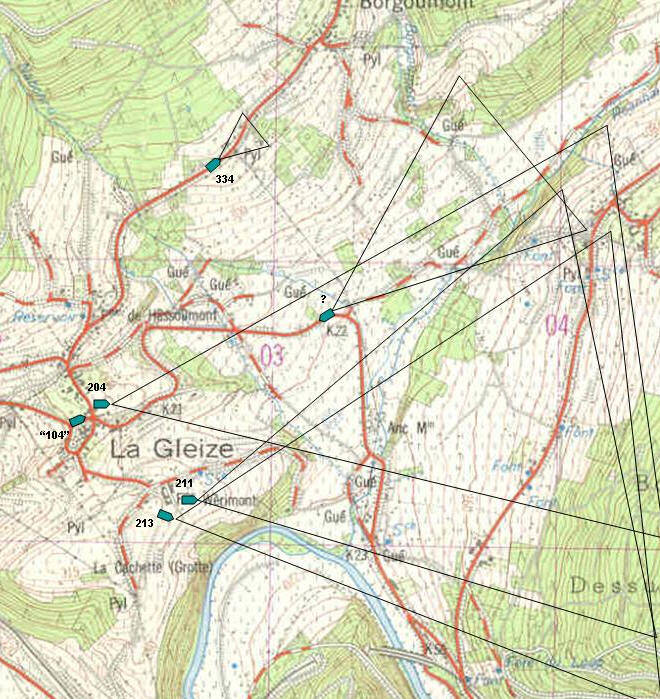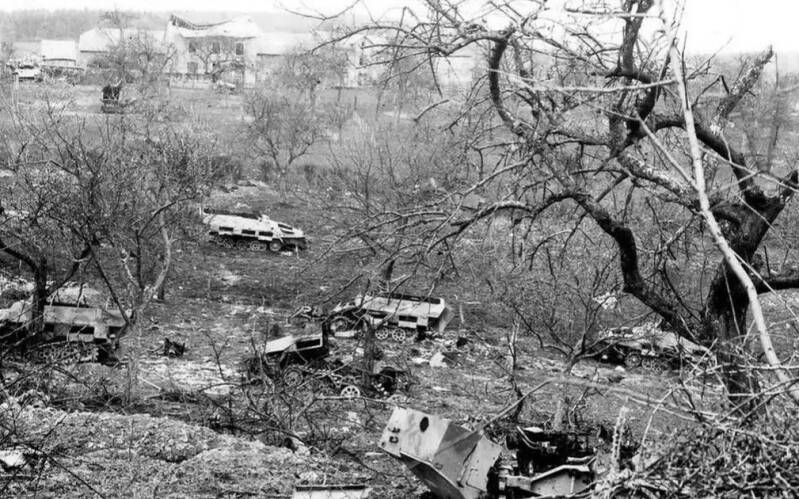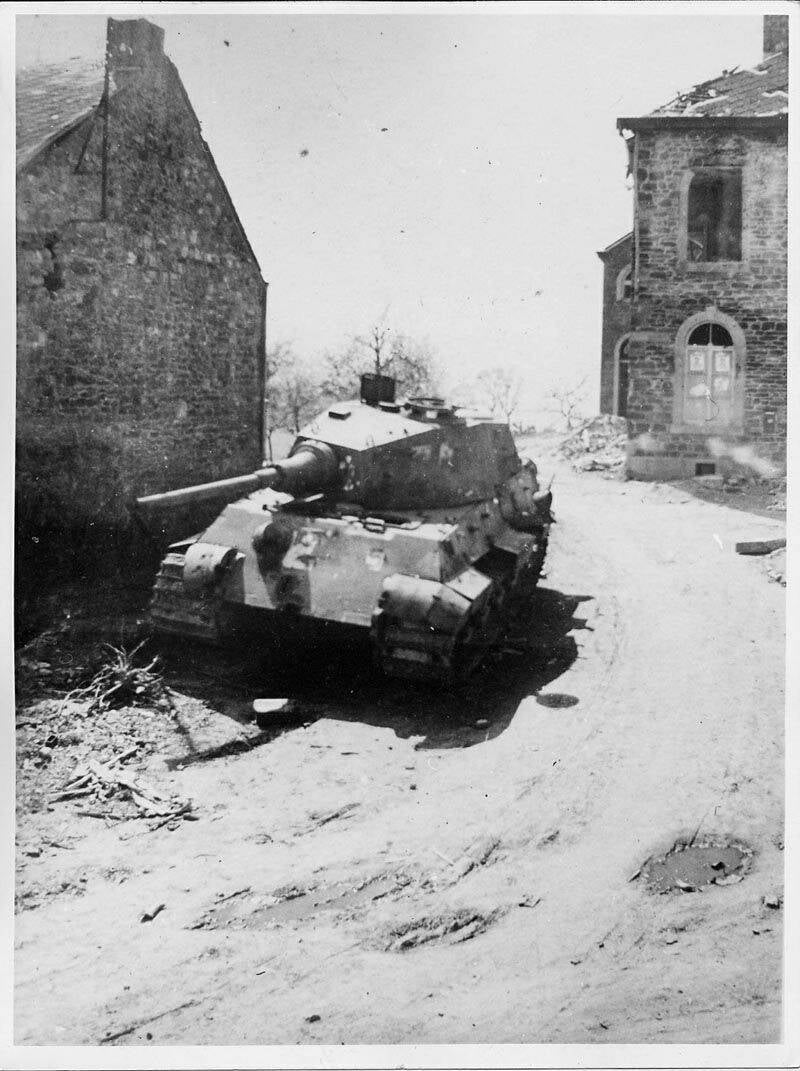Ardennes - Kampfgruppe Peiper
The Ardennes offensive was one of the final large offensives executed by the German armed forces in order to turn the tide on the allies. Also known as the Battle of the Bulge (the German called their operation “Wacht am Rhein”). The attack was performed by numerous German divisions. Spearhead of the 1st SS Panzer Division was the Kampfgruppe Peiper, which consisted of remnants of elite units bolstered together, including heavy Königstiger tanks. The Kampfgruppe managed to penetrate fairly deep into allied defensive lines until its lines became too stretched out. Counterattacks by the allies resulted in high German material losses and the retreat of the Kampfgruppe survivors.
Its notorious path can still be followed in the Ardennes region.
Three complete German armies were planned to attack the Ardennes region and push all the way towards Antwerpen and Brussel, cutting the US forces in the South from the British forces in the North. This could effectively create a second British Dunkirk and most favorably force the allies to negotiate with the Germans. This way the Germans could free up all their forces to assist on the Eastern front and push back the Russians.
This plan was just as realistic as the (bad) condition of the German forces; the three German armies consisted of some elite units:
- 1st LSSAH Panzer Division “LSSAH”
- 12th SS Panzer Division “Hitler Jugend”
- 2nd SS Panzer Division “Das Reich”
- 9th Panzer Division “Hohenstaufen”
- Otto Skorzeny’s 150th Panzer Brigade (infiltration commando’s)
- 9th/ 116th/ 2nd Panzer Division
- Panzer “Lehr” Division
- Fuhrer Begleit and Fuhrer Grenadier Brigades
- 3rd Fallschirmjager Division
- 16 different Volksgrenadier Divisions
- 2 separate Panzergrenadier Divisions
+ Many different small specialized battalions equipped with Jagdpanzers, Sturmpanzers and (Nebel)Werfers.
During the 1942/ 1943 period a combination of these units could have crushed huge allied troop concentrations – definitely entire Russian armies; or maybe even the entire British or US sector on the Western front. But only if all negative conditions wouldn’t have existed.
Many units were far beneath their troop- and/ or equipment strength. Although large numbers of veterans served within these units, all were supplemented with new soldiers which had almost no training: there was not enough time, fuel, training equipment or ammunition for this.
These same factors also influenced these divisions on the battlefield: there was a lack of fuel, lack of (artillery) ammunition, lack of logistics and all plans were made in a rush.
Furthermore the allies had air superiority and the German tactics had all wrong timings. The air superiority meant the German troops could not move during the day, during the night headlights could not be used which made their advances very slow. The allies on the other hand could advance at high speed during the day and at night they could use lights and good roads. And of course they could call in air support during battles.
The tactics used by the Germans had some poor decisions. In case of the heavy Königstiger tank: it was not suitable for the Ardennes. Small/ slippery roads, small bridges, villages, many creeks and continuously high/ low grounds were not favorable. The Königstiger was meant to fight in open ground, and take aim at medium or long distances. With its thick armor and 88mm canon it would be nearly invincible. It was not intended to drive long distances or on bad terrain – the heavy weight of this tank could damage the drive shaft, suspension, engine and gearbox very easily. Besides this it also needed much maintenance. All these factors combined made the Königstiger very impracticable for the Ardennes theatre.
During the operation more German flaws would surface. The different units would not advance together to protect their flanks. Some units did not have any or enough flak or reconnaissance vehicles. The Waffen SS doctrine stated that their most vulnerable tank, the Königstiger, should advance aggressively as the spearhead, which was what Peiper did. Behind these tanks the reconnaissance vehicles(!) followed to secure the area’s. During the vehicles/ tanks columns advance into the Ardennes many of these would get stranded and block the roads. Which resulted in many stranded and cut off groups.
In truth the complete offensive was a disaster. All negative aspects would downgrade the elite units from 100% effectiveness to maybe 30%. Large quantities of panzers and vehicles would be lost – which the German could not spare at all. All spend fuel, troops and ammo had eventually also no result.
It was a miracle that KG Peiper was able to advance all the way up to La Gleize. The only reason it was able to do so was the combat effectiveness and determination of the 1st SS Panzer Division crews.
The Stavelot – Trois Ponts – La Gleize route was spearheaded by Kampf Gruppe Peiper. Joachim Peiper was since the start of the German campaigns an adjutant and liaison in the highest staff – between Hitler and as personal staff of Himmler (head of SS) himself. Peiper was a young, well connected German nazi fanatic. On the Russian battlefield he gained command for the first time of a Waffen SS unit. He had the best soldiers, tactics and equipment; and, as a nazi, had no problem with war crimes. Many civilians and villages got burned to make way or to suppress possible resistance. In many cases he ordered his soldiers not to take prisoners of war but to execute them – in order to spare his own combat troops for guard duties or to simply lower enemy combat strength.
KG Peiper order of battle:
- 2x Company Panther Ausfuhrung G (each 13 tanks)
- 2x Company Panzer IV Ausfuhrung H (each 13 tanks)
- s.SS Panzer Abteilung 501 (42x Königstiger)
- Panzergrenadiere Regiment
- 150mm Self Propelled Artillery
- Paratroopers 9th Regiment
- Flakpanzer IV Wirbelwinds
- 20mm Vierlingsflak on halftracks
The offensive started around the 16th of December 1944 and on the 24th of December the remnants of KG Peiper which survived La Gleize were retreating on foot. In around one week KG Peiper and its units would lose a large quantity of their tanks and vehicles.
During the advance many Königstiger came in contact with the enemy – several of them being able to destroy multiple American tanks. Some Königstiger fought fiercely and only got disabled when attacked from multiple sides and in many cases from different types of US hardware: M10 tanks, M4 Shermans, 90mm Anti Air guns in ground mode, artillery, by air (fighter) bombers, mines or bazooka’s – and even captured Panzerfausts. Many Königstiger got stuck in ditches, buildings/ walls; lost their tracks or had all kinds of mechanical breakdowns. Most panzer crews tried to disable their own Königstiger when evacuating – not all succeeded in this.
All known exemplary Königstiger battles during the Ardennes offensive can be read in the recommended book ‘SS Panzer Battalion 501, Tiger in the Ardennes’ by Hugues Wenkin and Christian Dujardin.
The small town of La Gleize has a museum (December 44) with a large collection of equipment found on the battlefield. It is supplemented by uniforms, photo’s, medals and documents of this same battlefield period.
In front of the museum is the only Königstiger still out in the open in Europe! This was the original 213 which fought in KG Peiper to the end around the Werimont farm. It was left damaged (many impacts visible) and without fuel and ammo December 1944.
The Kampfgruppe Peiper route
The KG Peiper area of operations was set around the villages which were situated in a East-Western axis among the river Amblève. The river is a natural obstruction for vehicles so the bridges in these villages had a high value. A railway also ran parallel of the river Amblève, crossing the main advancing road at some points at which the roads passed underneath by tunnels. The German high command could not have chosen a worse path to advance their (heavy) panzers.
Several books and websites can be found to read all about the Kampfgruppe Peiper, The advances trhough the towns and the individual Königstigers. Therefore I will not explain these again - only refer to these books and website at the end of this page.
I will give an impression of the combat area of the Kampfgruppe with photographs and map references below:


213 Webimont farm La Gleize
After the Kampfgruppe advanced into the small village of La Gleize it was cut off from the East. Its spearhead was in the West towards Stoumont. Since it was cut off its Königstigers made a stand in La Gleize and the Webimont farm, covering the Eastern approaches.
From the East I made some overview photographs from high ground (which can be seen below), the area from which the US Task Force Lovelady would advance into the Kampfgruppe.

211 Webimont farm La Gleize




Werimont farm seen from different angles - its hill top overview clearly give a good covering of all surrounding area's. The Königstigers 211 and 213 would have a good visibility - with minimal cover as main disadvantage.



Werimont farm (white building) and bend in the N33 where a unknown Königstiger was positioned in the centre photograph. To the left and right of this photograph close ups of respectively those area's.



Near Stavelot a small bridge crosses the Ambleve river. Since the Germans were quite short of bridges a Jagdpanzer IV tried to cross it from the South in vain. The bridge could not hold the weight and it collapsed. Photograph above right view from the West: the Jagdpanzer can be seen to the left and in the background a Königstiger, no 133, which broke down. Close up of the Jagdpanzer IV to the left above and Königstiger 133 in the centre. Below the Petit Spay bridge seen from the South-West (same as the black and white photographs) with a map in the centre as reference of the area.



Below right the Trois Ponts (Eastern) railway tunnels which can also be seen on the map above in the centre. Below left a good reference of the carnage after the La Gleize battles - many hafltracks, armored and soft, and Panthers littered the area.















